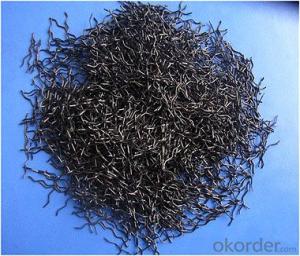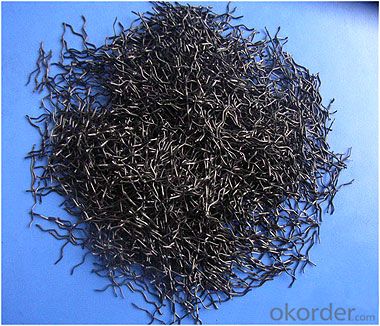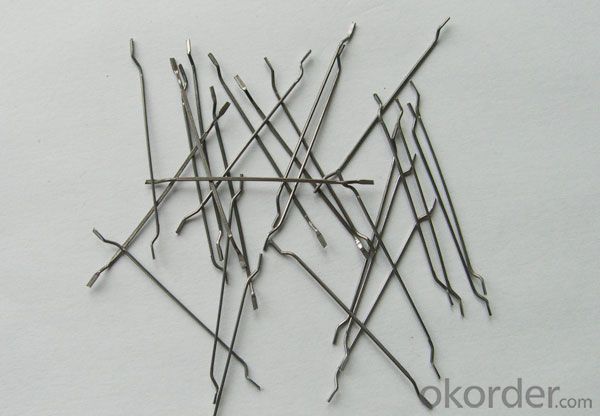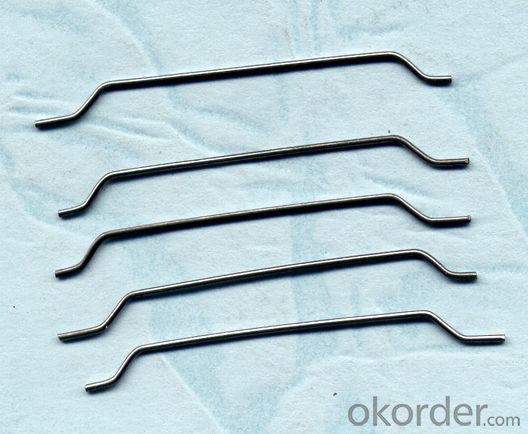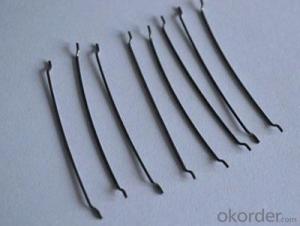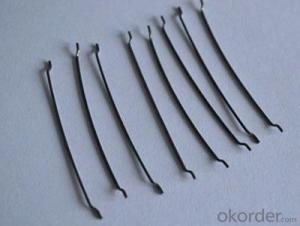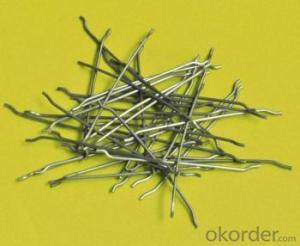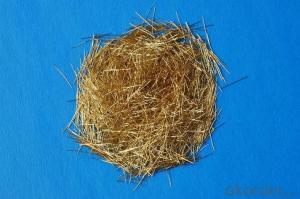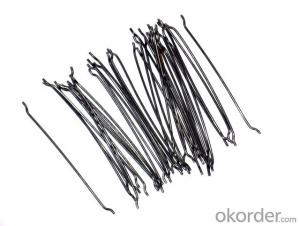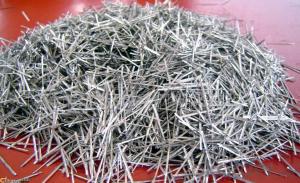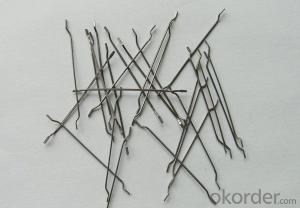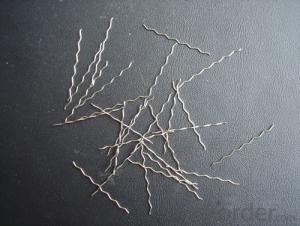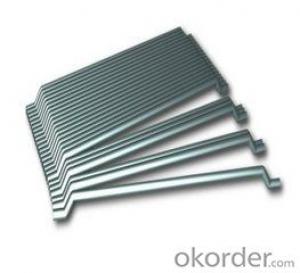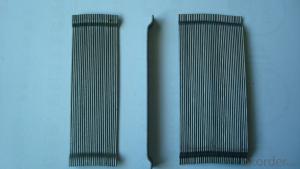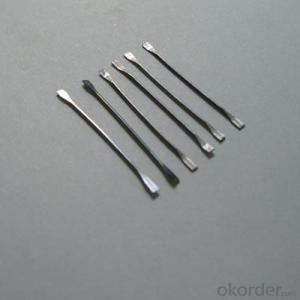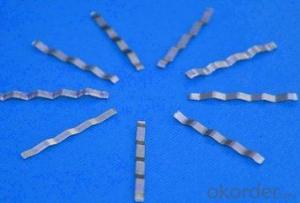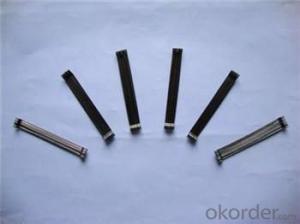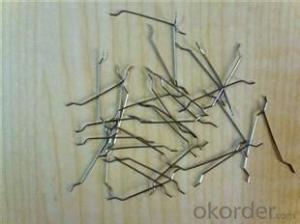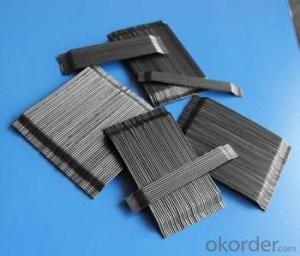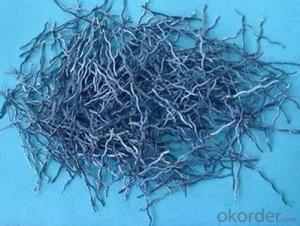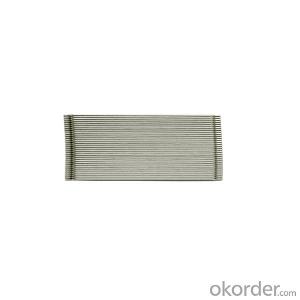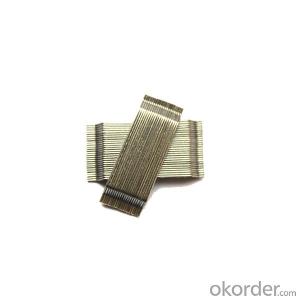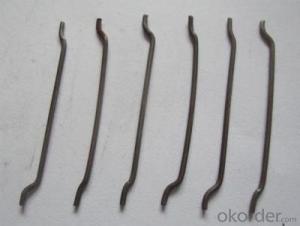Melt Extract Stainless Steel Fiber Wavy for Construction Wire Diameter
- Loading Port:
- Tianjin
- Payment Terms:
- TT OR LC
- Min Order Qty:
- 1000 kg
- Supply Capability:
- 250000 kg/month
OKorder Service Pledge
OKorder Financial Service
You Might Also Like
Quick Details
material: steel wire
shape: corrugated round fiber
appearance: clean and bright
usage: construction and concrete
Place of Origin: Shandong, China (Mainland)
Model Number: steel fiber
Product features
steel iber for concrete reinforcement ,it`s widely used in buildings ,bridges ,thin roof engineering ,highway etc
cncrete steel iber is specificially designed to enhance concrete in its hardened state ,the uniform distribution of steel fibers throughout the concrete greatly improves concrete bonding and tensile strength ,additionally it provides exceptional load stability and durability ,as reliable and efficient concrete reinforcement material .
Specifications
Length :20-60mm
Diameter :0.5-1.2
Tensile strength:600Mpa-900Mpa
Appearance :clear and bright steel wire
Style :corrugated round fiber
cncrete steel iber is specificially designed to enhance concrete in its hardened state ,the uniform distribution of steel fibers throughout the concrete greatly improves concrete bonding and tensile strength ,additionally it provides exceptional load stability and durability ,as reliable and efficient concrete reinforcement material .
it is widely used in buildings ,bridges ,thin roof engineering ,highway etc.
Picture
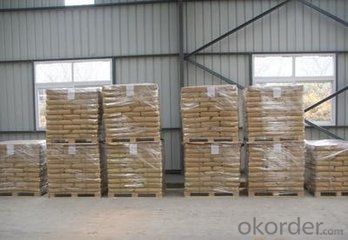
PP bag
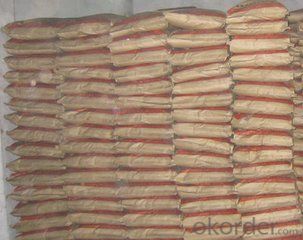
any type
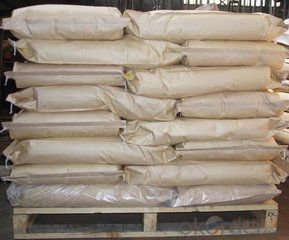
FAQ
we can produce any type steel fiber and of course we can make production according to your requirement
we have specilize in this field for almost 10 years ,with good quality and competitive price
- Q: Does melt extract stainless steel fiber enhance the crack resistance of concrete?
- Yes, melt extract stainless steel fiber does enhance the crack resistance of concrete. Stainless steel fibers are added to concrete mixes to improve its tensile strength and prevent the formation and propagation of cracks. The melt extract stainless steel fibers act as reinforcement within the concrete matrix, providing additional strength and durability. When properly dispersed throughout the concrete, these fibers create a three-dimensional network that helps distribute stress and load more evenly. This reduces the likelihood of cracks forming and spreading, and enhances the overall crack resistance of the concrete. Melt extract stainless steel fibers also have a high melting point and excellent corrosion resistance, making them particularly effective in harsh environments or when exposed to chemicals. These fibers can withstand high temperatures and prevent the concrete from spalling or cracking under extreme conditions. Furthermore, the addition of stainless steel fibers can improve the impact resistance and flexural strength of concrete, making it more resistant to cracking caused by external forces or dynamic loads. In conclusion, melt extract stainless steel fiber does enhance the crack resistance of concrete by reinforcing the material and improving its tensile strength. This results in a more durable and long-lasting concrete structure.
- Q: Can melt extract stainless steel fiber be used in tunnel linings for underground mining?
- Yes, melt extract stainless steel fiber can be used in tunnel linings for underground mining. These fibers are known for their high tensile strength and resistance to corrosion, making them suitable for reinforcing concrete in harsh environments such as mines. Additionally, their superior durability and ability to enhance the structural integrity of tunnel linings make them a reliable choice for underground mining applications.
- Q: What is the role of melt extract stainless steel fiber in refractory materials?
- The primary function of melt extract stainless steel fiber in refractory materials is to enhance their mechanical properties and performance. By adding stainless steel fibers to the refractory mix, reinforcement is provided and the material's resistance to thermal shock, cracking, and mechanical stress is improved. The melt extract process ensures that the stainless steel fibers possess a high level of purity and uniformity, rendering them suitable for high-temperature applications. Though added in small quantities, these fibers significantly enhance the refractory mix's strength, toughness, and resistance to wear and erosion. In addition, stainless steel fibers augment the refractory material's thermal conductivity and dimensional stability, enabling it to endure extreme temperatures without experiencing substantial deformation or deterioration. They establish a reinforcement network within the refractory matrix, preventing the spread of cracks and bolstering its overall durability. Moreover, stainless steel fibers can reinforce the refractory material's resistance to chemical attack and corrosion, making it appropriate for usage in aggressive environments. They can also improve the refractory's ability to retain heat, thereby enhancing energy efficiency in various industrial applications. In conclusion, the incorporation of melt extract stainless steel fibers into refractory materials significantly enhances their mechanical strength, thermal stability, and resistance to different forms of deterioration. This equips refractory materials to withstand challenging operating conditions and extend their lifespan, making them indispensable in industries like steelmaking, cement production, glass manufacturing, and petrochemical processing.
- Q: Is melt extract stainless steel fiber compatible with different types of shotcrete accelerators?
- Different types of shotcrete accelerators can be used with melt extract stainless steel fiber, as they are compatible. Shotcrete accelerators are employed to quicken the setting and hardening processes of shotcrete or concrete. To enhance the mechanical properties and durability of the final product, melt extract stainless steel fibers are frequently incorporated into shotcrete mixes. These fibers, made from stainless steel, possess exceptional corrosion resistance, allowing them to be compatible with various shotcrete accelerators. The inclusion of melt extract stainless steel fibers can bolster the bond strength, crack resistance, and impact resistance of shotcrete, regardless of the accelerator type. Thus, it is safe to assert that melt extract stainless steel fiber is compatible with different types of shotcrete accelerators.
- Q: Application of steel fiber concrete in water conservancy and hydropower project
- Steel fiber reinforced concrete is a new kind of multiphase composite material, which is made up of short steel fiber reinforced by random distribution in ordinary concrete. The chaos to the distribution of steel fiber can be formed effectively hinder the propagation of concrete internal micro cracks and macro cracks, improve concrete tensile strength, bending strength, impact resistance and fatigue performance, has good ductility.The fiber volume of ordinary steel fiber reinforced concrete at the rate of 1% to 2%, compared with ordinary concrete, the tensile strength increased from 40% to 80%, the flexural strength increased by 60% - 120%, the shear strength increased by 50% to 100%, the compressive strength increased slightly, generally 0 to 25%, but the compressive toughness is greatly improved.
- Q: Can melt extract stainless steel fiber be used in the construction of power plant structures?
- Yes, melt extract stainless steel fiber can be used in the construction of power plant structures. These fibers are known for their high temperature resistance, corrosion resistance, and durability, making them suitable for applications in power plants where extreme conditions such as high temperatures, pressure, and chemicals are present. They can enhance the strength and performance of concrete and other construction materials used in power plant structures, providing added reinforcement and ensuring long-term structural integrity.
- Q: What is the mechanism of steel fiber spacing enhancement?
- Through the analysis of composite theory and steel fiber spacing theory, it is proved that stainless steel fiber has the potential of higher resistance to cracking, and its tensile strength is improved remarkably,
- Q: Can melt extract stainless steel fiber be used in the construction of water storage tanks?
- Melt extract stainless steel fiber is a suitable material for the construction of water storage tanks. Its characteristics include high strength, durability, and corrosion resistance, which make it ideal for storing water. The fiber can endure the challenging conditions and chemicals commonly present in water tanks, guaranteeing prolonged functionality and reducing the chances of leaks or deterioration. Furthermore, the inclusion of stainless steel fiber improves the tank's structural integrity, reinforcing it and preventing cracks or failures. Ultimately, employing melt extract stainless steel fiber in water storage tank construction is a dependable and efficient option.
- Q: Can melt extract stainless steel fiber be used in swimming pool structures?
- Yes, melt extract stainless steel fiber can be used in swimming pool structures. Its corrosion resistance and durability make it suitable for use in water environments.
- Q: How does melt extract stainless steel fiber impact the load transfer between concrete layers?
- Melt extract stainless steel fiber has a significant impact on the load transfer between concrete layers. When added to the concrete mix, these fibers act as reinforcement, enhancing the tensile strength of the material. This reinforcement helps to distribute the load more evenly across the concrete layers, effectively transferring the applied load from one layer to another. The stainless steel fibers are uniformly dispersed within the concrete matrix, creating an interconnected network that enhances the overall structural integrity. As a result, the fibers prevent crack propagation and limit the development and widening of existing cracks between concrete layers. This behavior is crucial in load-bearing structures, as it improves the load-carrying capacity and durability of the concrete. Furthermore, the presence of melt extract stainless steel fibers helps to mitigate the effects of shrinkage and thermal stresses in concrete. These fibers reduce the likelihood of cracking caused by temperature fluctuations, as they provide reinforcement and prevent the formation of large cracks. This, in turn, enhances load transfer between layers by maintaining the structural integrity of the concrete. In summary, the addition of melt extract stainless steel fibers in concrete significantly improves the load transfer between layers. These fibers reinforce the concrete matrix, distribute the applied load more evenly, prevent crack propagation, and mitigate shrinkage and thermal stresses. Ultimately, this results in a stronger, more durable concrete structure with enhanced load-carrying capacity and longevity.
Send your message to us
Melt Extract Stainless Steel Fiber Wavy for Construction Wire Diameter
- Loading Port:
- Tianjin
- Payment Terms:
- TT OR LC
- Min Order Qty:
- 1000 kg
- Supply Capability:
- 250000 kg/month
OKorder Service Pledge
OKorder Financial Service
Similar products
Hot products
Hot Searches
Related keywords
